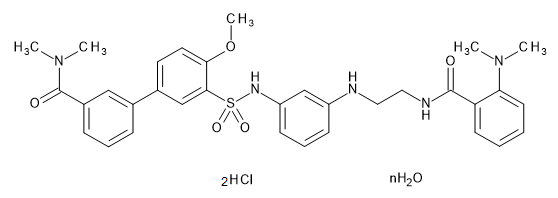Orexin Peptide & Non-peptide Orexin Receptor Agonist
Orexin Peptide
A neuropeptide produced by some neurons in the lateral hypothalamus, orexin-A and orexin-B are endogenous agonists of the orexin receptor. Two type of orexin receptors have been identified. The OX1 subtype has an affinity for orexin-A that is about 50 times more potent than for orexin-B, while the OX2 subtype exhibits an approximately equal affinity for both orexin-A and -B. It is reported that orexin is associated with sleep and wakefulness as well as food intake. In recent years, it has been found that orexin plays a major role in the sleep disorder narcolepsy.
| Product Name | Cat. No. | Package Size |
|---|---|---|
| Orexin A (Human) | 159-03161 | 0.1 mg |
| Orexin B (Human) | 156-03171 | 0.1 mg |
| Orexin B (Rat, Mouse) | 153-03181 | 0.1 mg |
Non-peptide Orexin 2 Receptor Agonist : YNT-185·2HCl
Overview
YNT-185·2HCl is non-peptide orexin receptor 2 (OX2R) agonist. Orexins are a family of neuropeptides, which are secreted by orexin-producingnerve present in the hypothalamus. There are two variants, orexin receptors exist as two types of receptors, type 1 and type 2. In particular, the orexin 2 receptor is involved in sleep-wake regulation, and orexin deficiency in the brain causes narcolepsy, a sleep disorder manifesting as an unbearable sleepiness during the day. Although it has been reported that intraventricular administration of orexin leads to symptom alleviation in narcolepsy mouse models, therapeutic effects cannot be expected unless it is administered into the brain, due to orexin being a peptide and being unable to pass through the blood-brain barrier. Intraventricular or intraperitoneal administration of YNT-185·2HCl has been shown to extend wake time, and has also been reported to improve the symptoms of narcolepsy mouse models.

- Appearance: White ~ slightly light brown, crystalline powder ~ powder
- Content (HPLC): 98.0% or more
- Solubility: Physiological saline (pH 2.4※) ... 1.3 mol/L1)
※ The optimum pH when dissolving is about 2.4 or less. - EC50: OX2R…0.028 μmol/L (free base)1)、OX1R…2.750 μmol/L (free base)1)
- C33H37N5O5S・2HCl・nH2O (C33H37N5O5S・2HCl=688.66)
- CAS RN® : 1804978-82-2 (anhydride)
Wake-Promoting Effect

When YNT-185·2HCl was intracerebroventricularly administered in mouse, volume-dependent increase of awaking level was shown. No awaking effect was observed in orexin-deficient mice. From this, it was confirmed that YNT-185・2HClhas an effect on orexin receptors.
(Data was provided by Yanagisawa M., Nagase H. and Funato H. at International Institute for Integrative Sleep Medicine (WPI-IIIS), University of Tsukuba)
References
- Nagahara, T., Saitoh, T., Kutsumura, N., Irukayama-Tomobe, Y., Ogawa, Y., Kuroda, D., Gouda, H., Kumagai, H., Fujii, H., Yanagisawa, M. and Nagase, H. :J. Med. Chem., 58, 7931 (2015).
- Irukayama-Tomobe, Y., Ogawa, Y., Tominaga, H., Ishikawa, Y., Hosokawa, N., Ambai, S., Kawabe, Y., Uchida, S., Nakajima, R., Saitoh, T., Kanda, T., Vogt, K., Sakurai, T., Nagase, H. and Yanagisawa, M. : Proc. Natl. Acad. Sci. USA, 114(22), 573(2017).
- Toyama, S., Shimoyama, N., Tagaito, Y., Nagase, H., Saitoh, T., Yanagisawa, M. and Shimoyama, M. : Anesthesiology, 128, 992 (2018).
- Yamamoto, K., Okui, R. and Yamatodani, A. : Naunyn Schmiedebergs Arch. Pharmacol. (2019). doi: 10.1007/s00210-019-01646-x.
Product List
- Open All
- Close All
Orexin Peptide
Non-peptide Orexin 2 Receptor Agonist
For research use or further manufacturing use only. Not for use in diagnostic procedures.
Product content may differ from the actual image due to minor specification changes etc.
If the revision of product standards and packaging standards has been made, there is a case where the actual product specifications and images are different.



